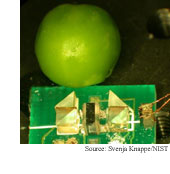|
NEWS
|
Coupled qubits
Link two superconducting quantum bits via an intermediate
qubit and it's possible to controllably couple qubits
to carry out quantum computations. The technique is a
key step toward large-scale quantum computers capable
of cracking secret codes and other useful work. (Quantum
Coherent Tunable Coupling of Superconducting Qubits,
Science, May 4, 2007)
Micro spectrometer
 A pea-size laser spectrometer packs a laser, a
chamber containing rubidium atoms, heaters and a photodetector.
The tiny spectrometer made from microfabricated components
could be used to fit more signals into telecommunications
channels and to calibrate scientific equipment. (Microfabricated
SaturaTed Absorption Laser Spectrometer, Optics
Express, May 14, 2007)
A pea-size laser spectrometer packs a laser, a
chamber containing rubidium atoms, heaters and a photodetector.
The tiny spectrometer made from microfabricated components
could be used to fit more signals into telecommunications
channels and to calibrate scientific equipment. (Microfabricated
SaturaTed Absorption Laser Spectrometer, Optics
Express, May 14, 2007)
Optical clocks break free
Transmit an ultraprecise optical clock's oscillations
over an optical fiber, then convert the clock's signal
to another frequency and you have a way to synchronize
optical clocks. The technique could be used to make telecommunications
networks faster and global positioning systems more precise.
(Coherent
Optical Link over Hundreds of Metres and Hundreds of Terahertz
with Subfemtosecond Timing Jitter, Nature Photonics,
May 1, 2007)
Bacterial bloodhounds
Genetically engineered E. coli bacteria track
down the sources of specific chemicals. The RNA-engineering
technique could lead to ways of harnessing bacteria for
delivering drugs, cleaning up pollution and transporting
chemicals. (Guiding
Bacteria with Small Molecules and RNA, Journal
of the American Chemical Society, published online
May 5, 2007)
DNA photography
A combination of fluorescence molecules and DNA
strands make it possible to detect small amounts of the
DNA using common photographic paper. The technique could
lead to inexpensive methods of detecting disease-causing
microorganisms. (DNA
Photography: An Ultrasensitive DNA-Detection Method Based
on Photographic Techniques, Angewandte Chemie,
published online April 13, 2007)
Silvery solar cells
Silver nanoparticles boost the amount of sunlight
absorbed by thin-film silicon solar cells. The technique
could make flexible and lower-cost photovoltaic devices
more efficient. (Surface
Plasmon Enhanced Silicon Solar Cells, Journal of
Applied Physics, May 1, 2007) |
FEATURES
|
View
from the High Ground: ICL's John Pendry
Physics as machine tool, negative refractive
index, metamaterials, shattered wine glasses, higher capacity
DVDs, scientific backwaters, risk perception and practice,
practice, practice.
|
How
It Works: Quantum computing: qubits
Photons, electrons and atoms, oh my! These particles are
the raw materials for qubits, the basic building blocks
of quantum computers. |
|
 |
News RSS feed 
Blog RSS feed 
Bookshelf RSS feed

New: TRN's
Internet Services
TRN's Jobs Center
|
| |
|
| |
|
| |
"Physics
is to the rest of science what machine tools are
to engineering. A corollary is that science places
power in our hands which can be used for good or
ill. Technology has been abused in this way throughout
the ages from gunpowder to atomic bombs."
- John Pendry, Imperial College London |
|
| |
|
| |
Thanks
to Kevin from
GoldBamboo.com
for technical support |
|

